Rio, IL Map & Demographics
Rio Map
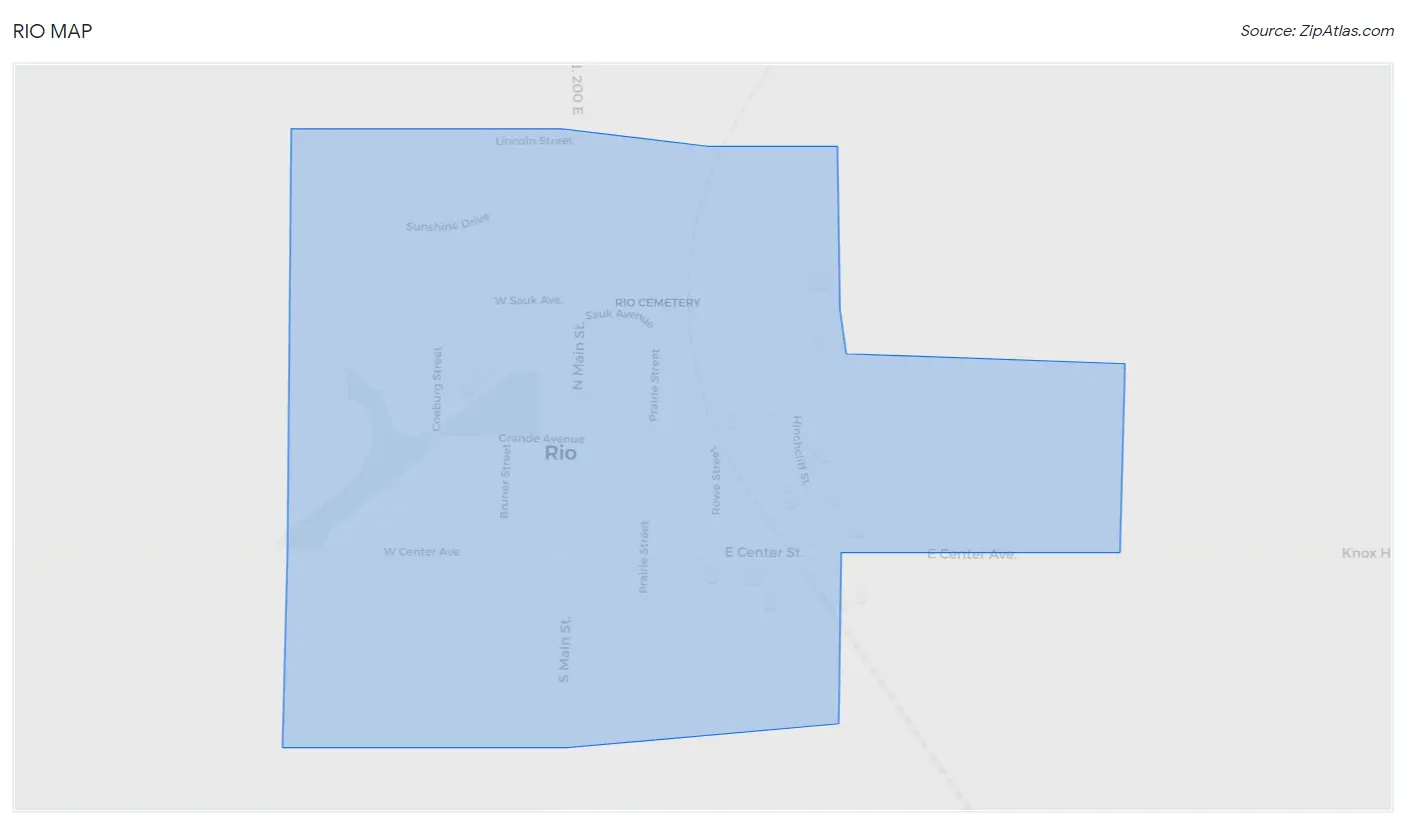
Rio Overview
$33,891
PER CAPITA INCOME
$86,875
AVG FAMILY INCOME
$73,750
AVG HOUSEHOLD INCOME
46.9%
WAGE / INCOME GAP [ % ]
53.1¢/ $1
WAGE / INCOME GAP [ $ ]
0.37
INEQUALITY / GINI INDEX
195
TOTAL POPULATION
86
MALE POPULATION
109
FEMALE POPULATION
78.90
MALES / 100 FEMALES
126.74
FEMALES / 100 MALES
46.1
MEDIAN AGE
2.8
AVG FAMILY SIZE
2.5
AVG HOUSEHOLD SIZE
106
LABOR FORCE [ PEOPLE ]
63.9%
PERCENT IN LABOR FORCE
4.7%
UNEMPLOYMENT RATE
Rio Zip Codes
Rio Area Codes
Income in Rio
Income Overview in Rio
Per Capita Income in Rio is $33,891, while median incomes of families and households are $86,875 and $73,750 respectively.
| Characteristic | Number | Measure |
| Per Capita Income | 195 | $33,891 |
| Median Family Income | 59 | $86,875 |
| Mean Family Income | 59 | $89,763 |
| Median Household Income | 79 | $73,750 |
| Mean Household Income | 79 | $80,753 |
| Income Deficit | 59 | $0 |
| Wage / Income Gap (%) | 195 | 46.89% |
| Wage / Income Gap ($) | 195 | 53.11¢ per $1 |
| Gini / Inequality Index | 195 | 0.37 |
Earnings by Sex in Rio
Average Earnings in Rio are $34,250, $47,857 for men and $25,417 for women, a difference of 46.9%.

| Sex | Number | Average Earnings |
| Male | 58 (54.2%) | $47,857 |
| Female | 49 (45.8%) | $25,417 |
| Total | 107 (100.0%) | $34,250 |
Earnings by Sex by Income Bracket in Rio
The most common earnings brackets in Rio are $45,000 to $49,999 for men (9 | 15.5%) and $12,500 to $14,999 for women (8 | 16.3%).
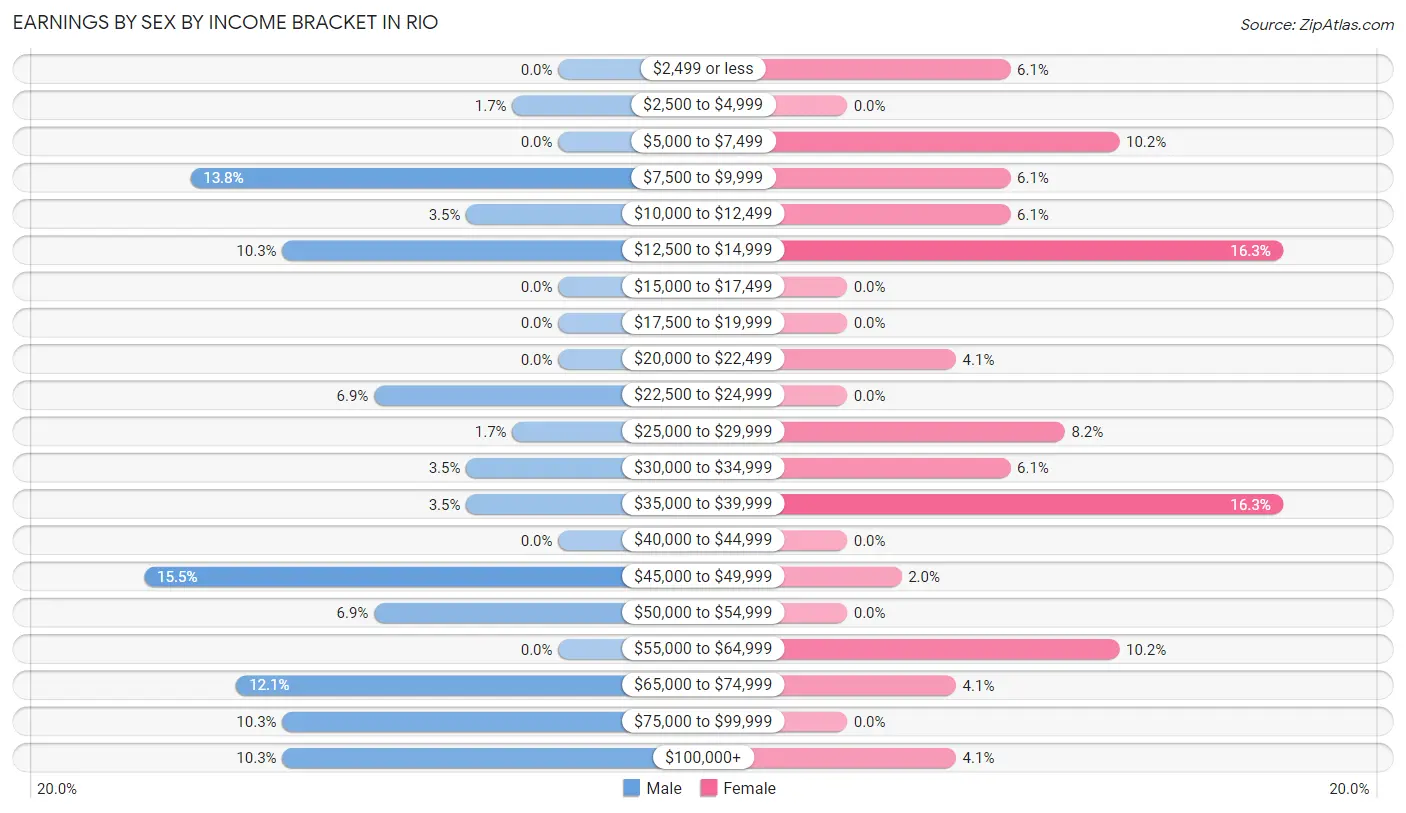
| Income | Male | Female |
| $2,499 or less | 0 (0.0%) | 3 (6.1%) |
| $2,500 to $4,999 | 1 (1.7%) | 0 (0.0%) |
| $5,000 to $7,499 | 0 (0.0%) | 5 (10.2%) |
| $7,500 to $9,999 | 8 (13.8%) | 3 (6.1%) |
| $10,000 to $12,499 | 2 (3.5%) | 3 (6.1%) |
| $12,500 to $14,999 | 6 (10.3%) | 8 (16.3%) |
| $15,000 to $17,499 | 0 (0.0%) | 0 (0.0%) |
| $17,500 to $19,999 | 0 (0.0%) | 0 (0.0%) |
| $20,000 to $22,499 | 0 (0.0%) | 2 (4.1%) |
| $22,500 to $24,999 | 4 (6.9%) | 0 (0.0%) |
| $25,000 to $29,999 | 1 (1.7%) | 4 (8.2%) |
| $30,000 to $34,999 | 2 (3.5%) | 3 (6.1%) |
| $35,000 to $39,999 | 2 (3.5%) | 8 (16.3%) |
| $40,000 to $44,999 | 0 (0.0%) | 0 (0.0%) |
| $45,000 to $49,999 | 9 (15.5%) | 1 (2.0%) |
| $50,000 to $54,999 | 4 (6.9%) | 0 (0.0%) |
| $55,000 to $64,999 | 0 (0.0%) | 5 (10.2%) |
| $65,000 to $74,999 | 7 (12.1%) | 2 (4.1%) |
| $75,000 to $99,999 | 6 (10.3%) | 0 (0.0%) |
| $100,000+ | 6 (10.3%) | 2 (4.1%) |
| Total | 58 (100.0%) | 49 (100.0%) |
Earnings by Sex by Educational Attainment in Rio
Average earnings in Rio are $49,821 for men and $31,250 for women, a difference of 37.3%. Men with an educational attainment of college or associate's degree enjoy the highest average annual earnings of $48,750, while those with college or associate's degree education earn the least with $48,750. Women with an educational attainment of college or associate's degree earn the most with the average annual earnings of $38,542, while those with high school diploma education have the smallest earnings of $13,929.

| Educational Attainment | Male Income | Female Income |
| Less than High School | - | - |
| High School Diploma | - | - |
| College or Associate's Degree | $48,750 | $38,542 |
| Bachelor's Degree | - | - |
| Graduate Degree | - | - |
| Total | $49,821 | $31,250 |
Family Income in Rio
Family Income Brackets in Rio
According to the Rio family income data, there are 19 families falling into the $75,000 to $99,999 income range, which is the most common income bracket and makes up 32.2% of all families.

| Income Bracket | # Families | % Families |
| Less than $10,000 | 3 | 5.1% |
| $10,000 to $14,999 | 1 | 1.7% |
| $15,000 to $24,999 | 0 | 0.0% |
| $25,000 to $34,999 | 7 | 11.9% |
| $35,000 to $49,999 | 9 | 15.3% |
| $50,000 to $74,999 | 4 | 6.8% |
| $75,000 to $99,999 | 19 | 32.2% |
| $100,000 to $149,999 | 9 | 15.3% |
| $150,000 to $199,999 | 3 | 5.1% |
| $200,000+ | 4 | 6.8% |
Family Income by Famaliy Size in Rio
2-person families (28 | 47.5%) account for the highest median family income in Rio with $90,000 per family, while 2-person families (28 | 47.5%) have the highest median income of $45,000 per family member.

| Income Bracket | # Families | Median Income |
| 2-Person Families | 28 (47.5%) | $90,000 |
| 3-Person Families | 21 (35.6%) | $87,292 |
| 4-Person Families | 1 (1.7%) | $0 |
| 5-Person Families | 7 (11.9%) | $0 |
| 6-Person Families | 2 (3.4%) | $0 |
| 7+ Person Families | 0 (0.0%) | $0 |
| Total | 59 (100.0%) | $86,875 |
Family Income by Number of Earners in Rio

| Number of Earners | # Families | Median Income |
| No Earners | 10 (17.0%) | $56,250 |
| 1 Earner | 17 (28.8%) | $0 |
| 2 Earners | 24 (40.7%) | $86,250 |
| 3+ Earners | 8 (13.6%) | $118,333 |
| Total | 59 (100.0%) | $86,875 |
Household Income in Rio
Household Income Brackets in Rio
With 21 households falling in the category, the $75,000 to $99,999 income range is the most frequent in Rio, accounting for 26.6% of all households. In contrast, only 2 households (2.5%) fall into the $10,000 to $14,999 income bracket, making it the least populous group.

| Income Bracket | # Households | % Households |
| Less than $10,000 | 3 | 3.8% |
| $10,000 to $14,999 | 2 | 2.5% |
| $15,000 to $24,999 | 2 | 2.5% |
| $25,000 to $34,999 | 9 | 11.4% |
| $35,000 to $49,999 | 17 | 21.5% |
| $50,000 to $74,999 | 7 | 8.9% |
| $75,000 to $99,999 | 21 | 26.6% |
| $100,000 to $149,999 | 11 | 13.9% |
| $150,000 to $199,999 | 3 | 3.8% |
| $200,000+ | 4 | 5.1% |
Household Income by Householder Age in Rio
The median household income in Rio is $73,750, with the highest median household income of $85,833 found in the 45 to 64 years age bracket for the primary householder. A total of 36 households (45.6%) fall into this category.

| Income Bracket | # Households | Median Income |
| 15 to 24 Years | 0 (0.0%) | $0 |
| 25 to 44 Years | 18 (22.8%) | $46,250 |
| 45 to 64 Years | 36 (45.6%) | $85,833 |
| 65+ Years | 25 (31.7%) | $64,375 |
| Total | 79 (100.0%) | $73,750 |
Poverty in Rio
Income Below Poverty by Sex and Age in Rio
With 10.5% poverty level for males and 23.8% for females among the residents of Rio, under 5 year old males and 12 to 14 year old females are the most vulnerable to poverty, with 1 males (100.0%) and 2 females (100.0%) in their respective age groups living below the poverty level.
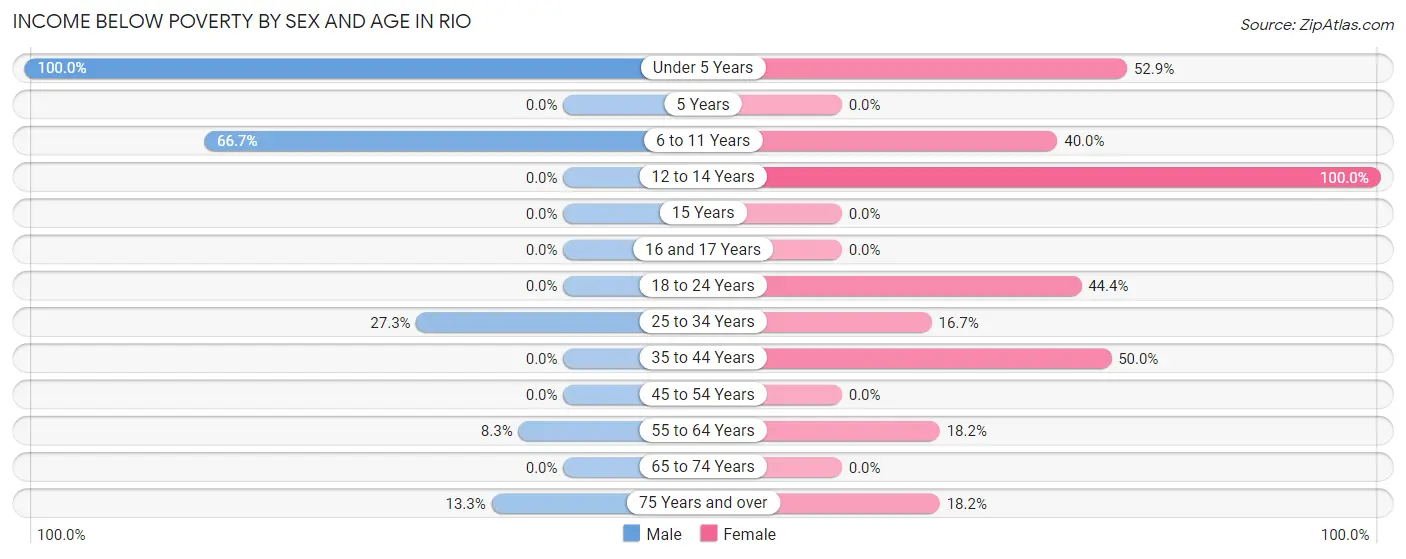
| Age Bracket | Male | Female |
| Under 5 Years | 1 (100.0%) | 9 (52.9%) |
| 5 Years | 0 (0.0%) | 0 (0.0%) |
| 6 to 11 Years | 2 (66.7%) | 2 (40.0%) |
| 12 to 14 Years | 0 (0.0%) | 2 (100.0%) |
| 15 Years | 0 (0.0%) | 0 (0.0%) |
| 16 and 17 Years | 0 (0.0%) | 0 (0.0%) |
| 18 to 24 Years | 0 (0.0%) | 4 (44.4%) |
| 25 to 34 Years | 3 (27.3%) | 3 (16.7%) |
| 35 to 44 Years | 0 (0.0%) | 2 (50.0%) |
| 45 to 54 Years | 0 (0.0%) | 0 (0.0%) |
| 55 to 64 Years | 1 (8.3%) | 2 (18.2%) |
| 65 to 74 Years | 0 (0.0%) | 0 (0.0%) |
| 75 Years and over | 2 (13.3%) | 2 (18.2%) |
| Total | 9 (10.5%) | 26 (23.8%) |
Income Above Poverty by Sex and Age in Rio
According to the poverty statistics in Rio, males aged 15 years and females aged 45 to 54 years are the age groups that are most secure financially, with 100.0% of males and 100.0% of females in these age groups living above the poverty line.
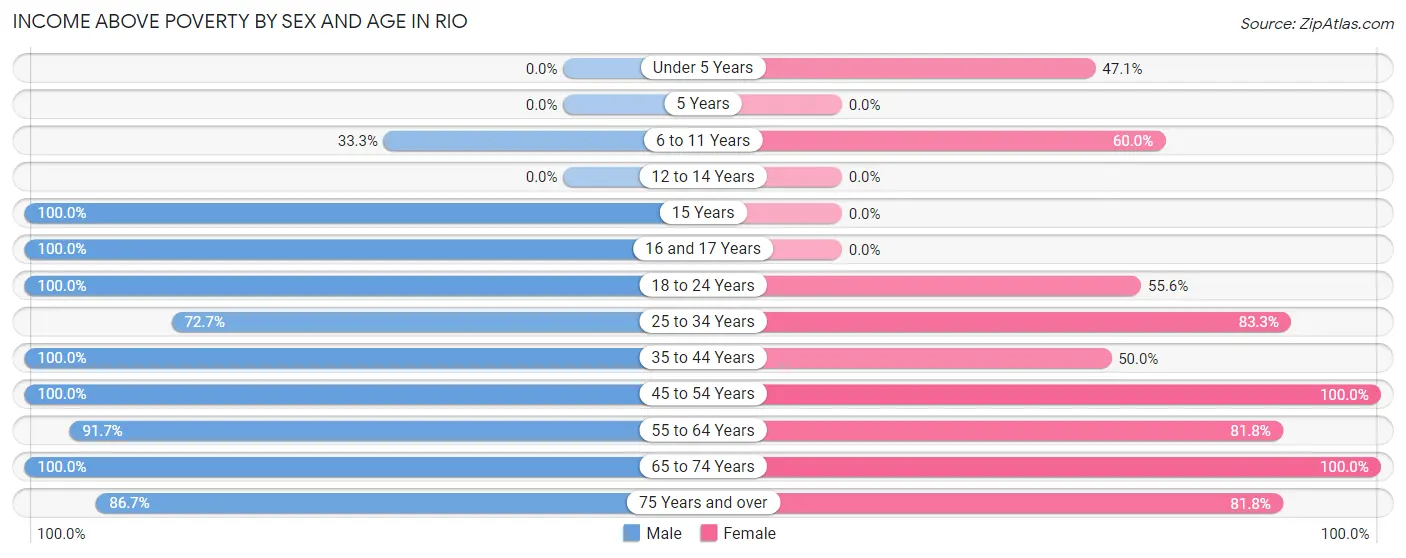
| Age Bracket | Male | Female |
| Under 5 Years | 0 (0.0%) | 8 (47.1%) |
| 5 Years | 0 (0.0%) | 0 (0.0%) |
| 6 to 11 Years | 1 (33.3%) | 3 (60.0%) |
| 12 to 14 Years | 0 (0.0%) | 0 (0.0%) |
| 15 Years | 1 (100.0%) | 0 (0.0%) |
| 16 and 17 Years | 2 (100.0%) | 0 (0.0%) |
| 18 to 24 Years | 12 (100.0%) | 5 (55.6%) |
| 25 to 34 Years | 8 (72.7%) | 15 (83.3%) |
| 35 to 44 Years | 9 (100.0%) | 2 (50.0%) |
| 45 to 54 Years | 15 (100.0%) | 22 (100.0%) |
| 55 to 64 Years | 11 (91.7%) | 9 (81.8%) |
| 65 to 74 Years | 5 (100.0%) | 10 (100.0%) |
| 75 Years and over | 13 (86.7%) | 9 (81.8%) |
| Total | 77 (89.5%) | 83 (76.1%) |
Income Below Poverty Among Married-Couple Families in Rio
The poverty statistics for married-couple families in Rio show that 2.4% or 1 of the total 42 families live below the poverty line. Families with no children have the highest poverty rate of 3.1%, comprising of 1 families. On the other hand, families with 1 or 2 children have the lowest poverty rate of 0.0%, which includes 0 families.

| Children | Above Poverty | Below Poverty |
| No Children | 31 (96.9%) | 1 (3.1%) |
| 1 or 2 Children | 8 (100.0%) | 0 (0.0%) |
| 3 or 4 Children | 2 (100.0%) | 0 (0.0%) |
| 5 or more Children | 0 (0.0%) | 0 (0.0%) |
| Total | 41 (97.6%) | 1 (2.4%) |
Income Below Poverty Among Single-Parent Households in Rio
According to the poverty data in Rio, 50.0% or 3 single-father households and 18.2% or 2 single-mother households are living below the poverty line. Among single-father households, those with 3 or 4 children have the highest poverty rate, with 3 households (100.0%) experiencing poverty. Likewise, among single-mother households, those with 3 or 4 children have the highest poverty rate, with 2 households (100.0%) falling below the poverty line.

| Children | Single Father | Single Mother |
| No Children | 0 (0.0%) | 0 (0.0%) |
| 1 or 2 Children | 0 (0.0%) | 0 (0.0%) |
| 3 or 4 Children | 3 (100.0%) | 2 (100.0%) |
| 5 or more Children | 0 (0.0%) | 0 (0.0%) |
| Total | 3 (50.0%) | 2 (18.2%) |
Income Below Poverty Among Married-Couple vs Single-Parent Households in Rio
The poverty data for Rio shows that 1 of the married-couple family households (2.4%) and 5 of the single-parent households (29.4%) are living below the poverty level. Within the married-couple family households, those with no children have the highest poverty rate, with 1 households (3.1%) falling below the poverty line. Among the single-parent households, those with 3 or 4 children have the highest poverty rate, with 5 household (100.0%) living below poverty.

| Children | Married-Couple Families | Single-Parent Households |
| No Children | 1 (3.1%) | 0 (0.0%) |
| 1 or 2 Children | 0 (0.0%) | 0 (0.0%) |
| 3 or 4 Children | 0 (0.0%) | 5 (100.0%) |
| 5 or more Children | 0 (0.0%) | 0 (0.0%) |
| Total | 1 (2.4%) | 5 (29.4%) |
Race in Rio
The most populous races in Rio are White / Caucasian (189 | 96.9%), Hispanic or Latino (19 | 9.7%), and Black / African American (3 | 1.5%).

| Race | # Population | % Population |
| Asian | 0 | 0.0% |
| Black / African American | 3 | 1.5% |
| Hawaiian / Pacific | 0 | 0.0% |
| Hispanic or Latino | 19 | 9.7% |
| Native / Alaskan | 0 | 0.0% |
| White / Caucasian | 189 | 96.9% |
| Two or more Races | 3 | 1.5% |
| Some other Race | 0 | 0.0% |
| Total | 195 | 100.0% |
Ancestry in Rio
The most populous ancestries reported in Rio are Irish (35 | 17.9%), German (30 | 15.4%), English (17 | 8.7%), American (13 | 6.7%), and Swedish (13 | 6.7%), together accounting for 55.4% of all Rio residents.
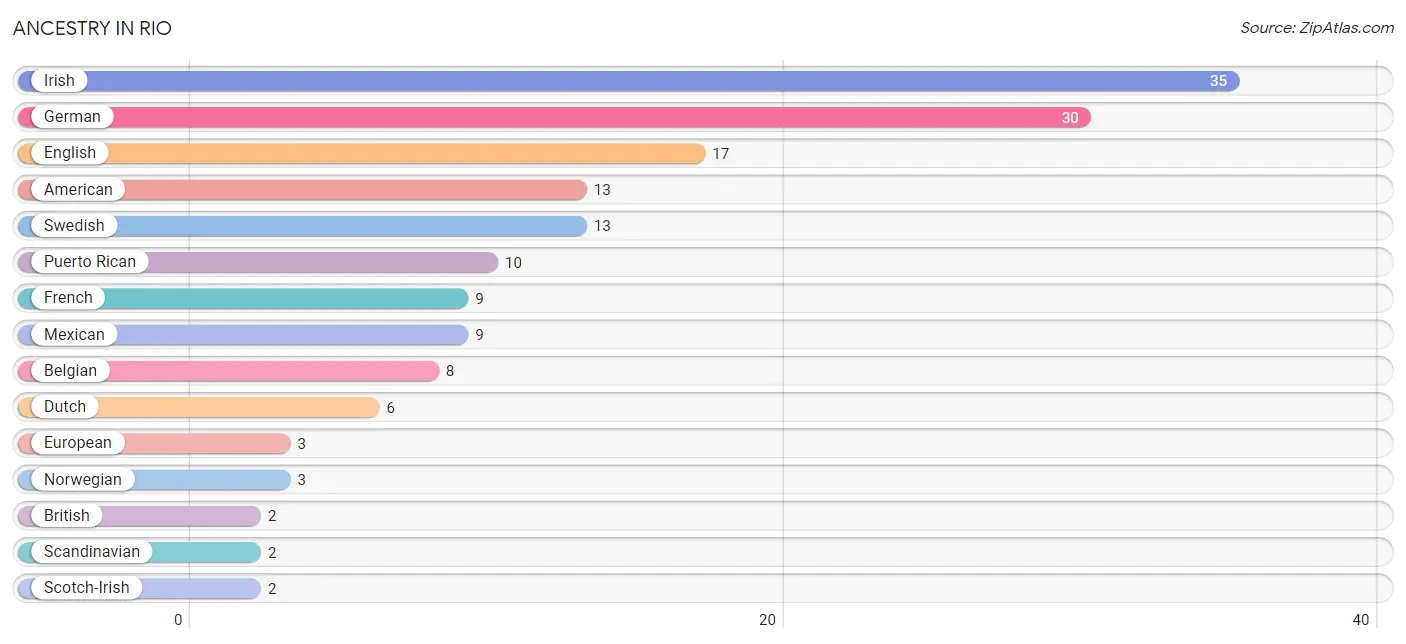
| Ancestry | # Population | % Population |
| American | 13 | 6.7% |
| Belgian | 8 | 4.1% |
| British | 2 | 1.0% |
| Dutch | 6 | 3.1% |
| Eastern European | 1 | 0.5% |
| English | 17 | 8.7% |
| European | 3 | 1.5% |
| French | 9 | 4.6% |
| German | 30 | 15.4% |
| Irish | 35 | 17.9% |
| Italian | 1 | 0.5% |
| Mexican | 9 | 4.6% |
| Norwegian | 3 | 1.5% |
| Pennsylvania German | 1 | 0.5% |
| Puerto Rican | 10 | 5.1% |
| Scandinavian | 2 | 1.0% |
| Scotch-Irish | 2 | 1.0% |
| Swedish | 13 | 6.7% |
| Swiss | 1 | 0.5% | View All 19 Rows |
Immigrants in Rio

| Immigration Origin | # Population | % Population | View All 0 Rows |
Sex and Age in Rio
Sex and Age in Rio
The most populous age groups in Rio are 45 to 49 Years (12 | 14.0%) for men and Under 5 Years (17 | 15.6%) for women.
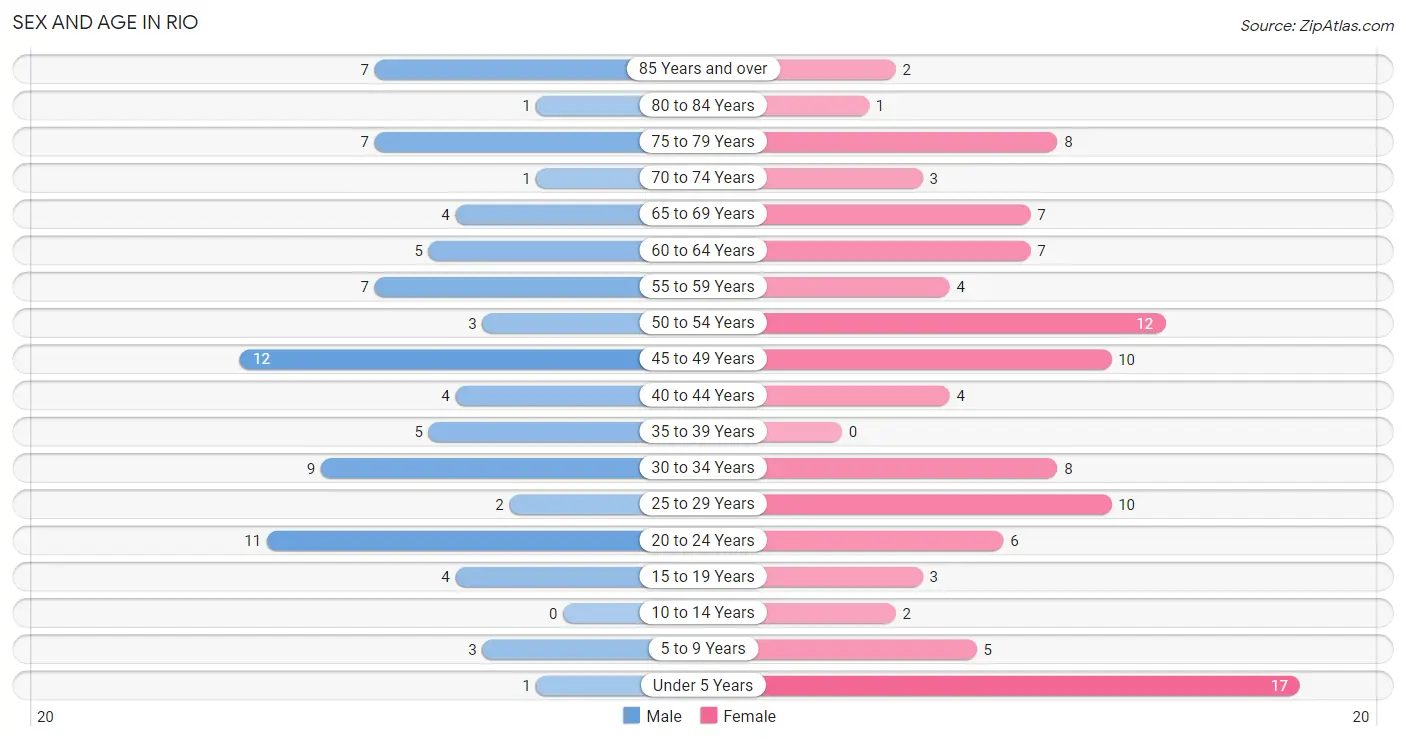
| Age Bracket | Male | Female |
| Under 5 Years | 1 (1.2%) | 17 (15.6%) |
| 5 to 9 Years | 3 (3.5%) | 5 (4.6%) |
| 10 to 14 Years | 0 (0.0%) | 2 (1.8%) |
| 15 to 19 Years | 4 (4.6%) | 3 (2.8%) |
| 20 to 24 Years | 11 (12.8%) | 6 (5.5%) |
| 25 to 29 Years | 2 (2.3%) | 10 (9.2%) |
| 30 to 34 Years | 9 (10.5%) | 8 (7.3%) |
| 35 to 39 Years | 5 (5.8%) | 0 (0.0%) |
| 40 to 44 Years | 4 (4.6%) | 4 (3.7%) |
| 45 to 49 Years | 12 (14.0%) | 10 (9.2%) |
| 50 to 54 Years | 3 (3.5%) | 12 (11.0%) |
| 55 to 59 Years | 7 (8.1%) | 4 (3.7%) |
| 60 to 64 Years | 5 (5.8%) | 7 (6.4%) |
| 65 to 69 Years | 4 (4.6%) | 7 (6.4%) |
| 70 to 74 Years | 1 (1.2%) | 3 (2.8%) |
| 75 to 79 Years | 7 (8.1%) | 8 (7.3%) |
| 80 to 84 Years | 1 (1.2%) | 1 (0.9%) |
| 85 Years and over | 7 (8.1%) | 2 (1.8%) |
| Total | 86 (100.0%) | 109 (100.0%) |
Families and Households in Rio
Median Family Size in Rio
The median family size in Rio is 2.83 persons per family, with single male/father families (6 | 10.2%) accounting for the largest median family size of 3.33 persons per family. On the other hand, married-couple families (42 | 71.2%) represent the smallest median family size with 2.69 persons per family.

| Family Type | # Families | Family Size |
| Married-Couple | 42 (71.2%) | 2.69 |
| Single Male/Father | 6 (10.2%) | 3.33 |
| Single Female/Mother | 11 (18.6%) | 3.09 |
| Total Families | 59 (100.0%) | 2.83 |
Median Household Size in Rio
The median household size in Rio is 2.47 persons per household, with single male/father households (6 | 7.6%) accounting for the largest median household size of 3.83 persons per household. non-family households (20 | 25.3%) represent the smallest median household size with 1.10 persons per household.

| Household Type | # Households | Household Size |
| Married-Couple | 42 (53.2%) | 2.69 |
| Single Male/Father | 6 (7.6%) | 3.83 |
| Single Female/Mother | 11 (13.9%) | 3.36 |
| Non-family | 20 (25.3%) | 1.10 |
| Total Households | 79 (100.0%) | 2.47 |
Household Size by Marriage Status in Rio
Out of a total of 79 households in Rio, 59 (74.7%) are family households, while 20 (25.3%) are nonfamily households. The most numerous type of family households are 2-person households, comprising 27, and the most common type of nonfamily households are 1-person households, comprising 19.

| Household Size | Family Households | Nonfamily Households |
| 1-Person Households | - | 19 (24.0%) |
| 2-Person Households | 27 (34.2%) | 1 (1.3%) |
| 3-Person Households | 22 (27.9%) | 0 (0.0%) |
| 4-Person Households | 1 (1.3%) | 0 (0.0%) |
| 5-Person Households | 4 (5.1%) | 0 (0.0%) |
| 6-Person Households | 3 (3.8%) | 0 (0.0%) |
| 7+ Person Households | 2 (2.5%) | 0 (0.0%) |
| Total | 59 (74.7%) | 20 (25.3%) |
Female Fertility in Rio
Fertility by Age in Rio
Average fertility rate in Rio is 47.0 births per 1,000 women. Women in the age bracket of 20 to 34 years have the highest fertility rate with 83.0 births per 1,000 women. Women in the age bracket of 20 to 34 years acount for 100.0% of all women with births.

| Age Bracket | Women with Births | Births / 1,000 Women |
| 15 to 19 years | 0 (0.0%) | 0.0 |
| 20 to 34 years | 2 (100.0%) | 83.0 |
| 35 to 50 years | 0 (0.0%) | 0.0 |
| Total | 2 (100.0%) | 47.0 |
Fertility by Age by Marriage Status in Rio

| Age Bracket | Married | Unmarried |
| 15 to 19 years | 0 (0.0%) | 0 (0.0%) |
| 20 to 34 years | 0 (0.0%) | 2 (100.0%) |
| 35 to 50 years | 0 (0.0%) | 0 (0.0%) |
| Total | 0 (0.0%) | 2 (100.0%) |
Fertility by Education in Rio
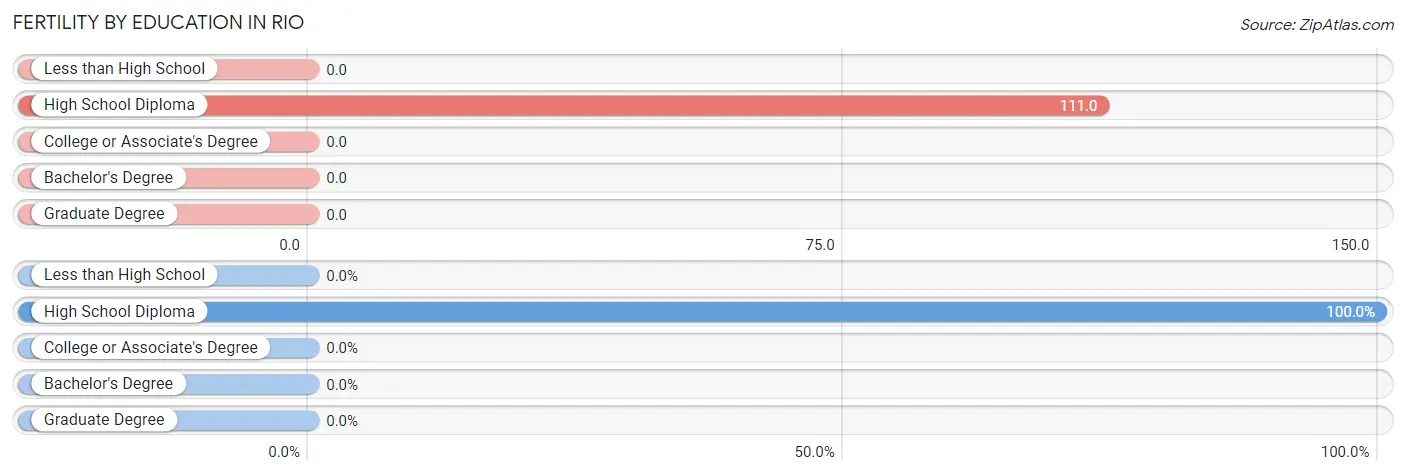
| Educational Attainment | Women with Births | Births / 1,000 Women |
| Less than High School | 0 (0.0%) | 0.0 |
| High School Diploma | 2 (100.0%) | 111.0 |
| College or Associate's Degree | 0 (0.0%) | 0.0 |
| Bachelor's Degree | 0 (0.0%) | 0.0 |
| Graduate Degree | 0 (0.0%) | 0.0 |
| Total | 2 (100.0%) | 47.0 |
Fertility by Education by Marriage Status in Rio

| Educational Attainment | Married | Unmarried |
| Less than High School | 0 (0.0%) | 0 (0.0%) |
| High School Diploma | 0 (0.0%) | 2 (100.0%) |
| College or Associate's Degree | 0 (0.0%) | 0 (0.0%) |
| Bachelor's Degree | 0 (0.0%) | 0 (0.0%) |
| Graduate Degree | 0 (0.0%) | 0 (0.0%) |
| Total | 0 (0.0%) | 2 (100.0%) |
Employment Characteristics in Rio
Employment by Class of Employer in Rio
Among the 101 employed individuals in Rio, private company employees (79 | 78.2%), local government employees (8 | 7.9%), and not-for-profit organizations (5 | 5.0%) make up the most common classes of employment.

| Employer Class | # Employees | % Employees |
| Private Company Employees | 79 | 78.2% |
| Self-Employed (Incorporated) | 4 | 4.0% |
| Self-Employed (Not Incorporated) | 2 | 2.0% |
| Not-for-profit Organizations | 5 | 5.0% |
| Local Government Employees | 8 | 7.9% |
| State Government Employees | 2 | 2.0% |
| Federal Government Employees | 1 | 1.0% |
| Unpaid Family Workers | 0 | 0.0% |
| Total | 101 | 100.0% |
Employment Status by Age in Rio
According to the labor force statistics for Rio, out of the total population over 16 years of age (166), 63.9% or 106 individuals are in the labor force, with 4.7% or 5 of them unemployed. The age group with the highest labor force participation rate is 20 to 24 years, with 100.0% or 17 individuals in the labor force. Within the labor force, the 16 to 19 years age range has the highest percentage of unemployed individuals, with 25.0% or 1 of them being unemployed.

| Age Bracket | In Labor Force | Unemployed |
| 16 to 19 Years | 4 (66.7%) | 1 (25.0%) |
| 20 to 24 Years | 17 (100.0%) | 4 (23.5%) |
| 25 to 29 Years | 12 (100.0%) | 0 (0.0%) |
| 30 to 34 Years | 11 (64.7%) | 0 (0.0%) |
| 35 to 44 Years | 13 (100.0%) | 0 (0.0%) |
| 45 to 54 Years | 28 (75.7%) | 0 (0.0%) |
| 55 to 59 Years | 8 (72.7%) | 0 (0.0%) |
| 60 to 64 Years | 8 (66.7%) | 0 (0.0%) |
| 65 to 74 Years | 4 (26.7%) | 0 (0.0%) |
| 75 Years and over | 1 (3.8%) | 0 (0.0%) |
| Total | 106 (63.9%) | 5 (4.7%) |
Employment Status by Educational Attainment in Rio

| Educational Attainment | In Labor Force | Unemployed |
| Less than High School | 4 (100.0%) | 0 (0.0%) |
| High School Diploma | 24 (58.5%) | 0 (0.0%) |
| College / Associate Degree | 33 (86.8%) | 0 (0.0%) |
| Bachelor's Degree or higher | 19 (100.0%) | 0 (0.0%) |
| Total | 80 (78.4%) | 0 (0.0%) |
Employment Occupations by Sex in Rio
Management, Business, Science and Arts Occupations
The most common Management, Business, Science and Arts occupations in Rio are Community & Social Service (11 | 10.9%), Computers, Engineering & Science (9 | 8.9%), Education Instruction & Library (8 | 7.9%), Management (7 | 6.9%), and Architecture & Engineering (6 | 5.9%).
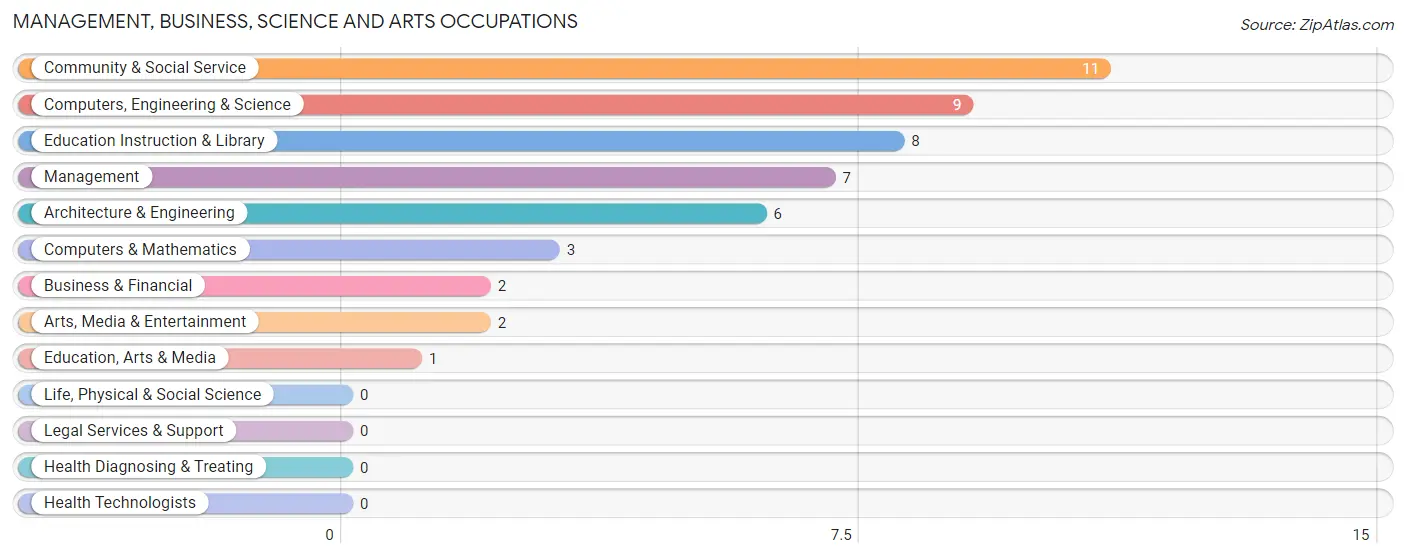
Management, Business, Science and Arts Occupations by Sex
Within the Management, Business, Science and Arts occupations in Rio, the most male-oriented occupations are Architecture & Engineering (100.0%), Education, Arts & Media (100.0%), and Arts, Media & Entertainment (100.0%), while the most female-oriented occupations are Business & Financial (100.0%), Computers & Mathematics (100.0%), and Education Instruction & Library (87.5%).
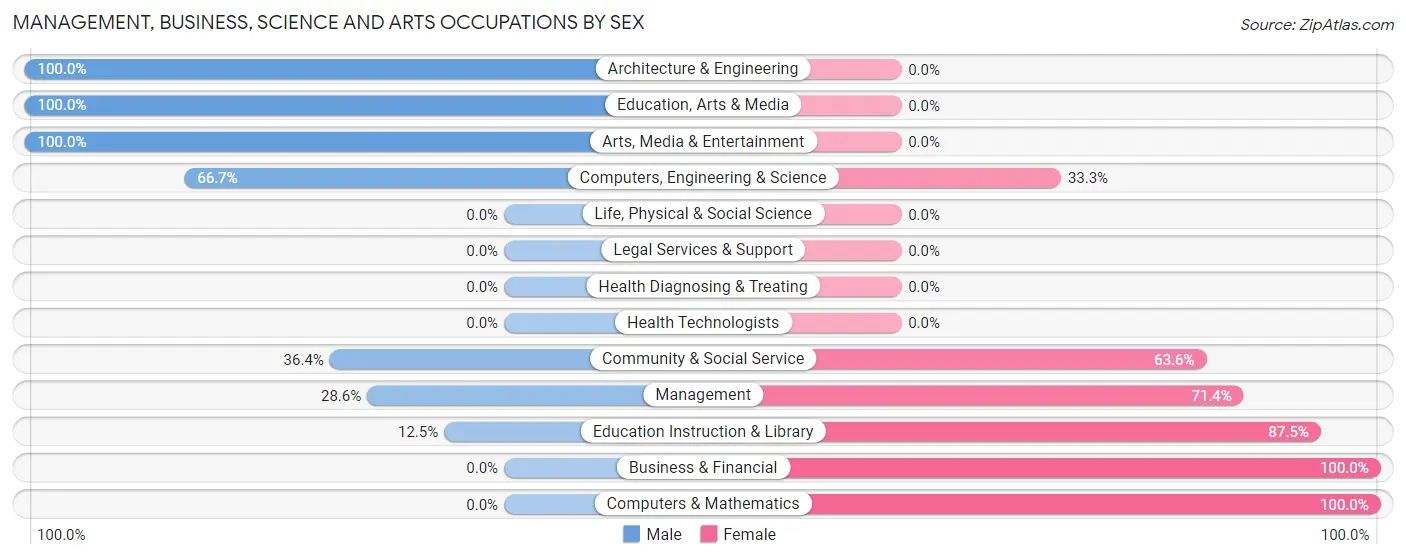
| Occupation | Male | Female |
| Management | 2 (28.6%) | 5 (71.4%) |
| Business & Financial | 0 (0.0%) | 2 (100.0%) |
| Computers, Engineering & Science | 6 (66.7%) | 3 (33.3%) |
| Computers & Mathematics | 0 (0.0%) | 3 (100.0%) |
| Architecture & Engineering | 6 (100.0%) | 0 (0.0%) |
| Life, Physical & Social Science | 0 (0.0%) | 0 (0.0%) |
| Community & Social Service | 4 (36.4%) | 7 (63.6%) |
| Education, Arts & Media | 1 (100.0%) | 0 (0.0%) |
| Legal Services & Support | 0 (0.0%) | 0 (0.0%) |
| Education Instruction & Library | 1 (12.5%) | 7 (87.5%) |
| Arts, Media & Entertainment | 2 (100.0%) | 0 (0.0%) |
| Health Diagnosing & Treating | 0 (0.0%) | 0 (0.0%) |
| Health Technologists | 0 (0.0%) | 0 (0.0%) |
| Total (Category) | 12 (41.4%) | 17 (58.6%) |
| Total (Overall) | 58 (57.4%) | 43 (42.6%) |
Services Occupations
The most common Services occupations in Rio are Healthcare Support (2 | 2.0%), and Cleaning & Maintenance (1 | 1.0%).

Services Occupations by Sex

| Occupation | Male | Female |
| Healthcare Support | 0 (0.0%) | 2 (100.0%) |
| Security & Protection | 0 (0.0%) | 0 (0.0%) |
| Firefighting & Prevention | 0 (0.0%) | 0 (0.0%) |
| Law Enforcement | 0 (0.0%) | 0 (0.0%) |
| Food Preparation & Serving | 0 (0.0%) | 0 (0.0%) |
| Cleaning & Maintenance | 0 (0.0%) | 1 (100.0%) |
| Personal Care & Service | 0 (0.0%) | 0 (0.0%) |
| Total (Category) | 0 (0.0%) | 3 (100.0%) |
| Total (Overall) | 58 (57.4%) | 43 (42.6%) |
Sales and Office Occupations
The most common Sales and Office occupations in Rio are Office & Administration (16 | 15.8%), and Sales & Related (7 | 6.9%).

Sales and Office Occupations by Sex

| Occupation | Male | Female |
| Sales & Related | 2 (28.6%) | 5 (71.4%) |
| Office & Administration | 8 (50.0%) | 8 (50.0%) |
| Total (Category) | 10 (43.5%) | 13 (56.5%) |
| Total (Overall) | 58 (57.4%) | 43 (42.6%) |
Natural Resources, Construction and Maintenance Occupations
The most common Natural Resources, Construction and Maintenance occupations in Rio are Installation, Maintenance & Repair (5 | 5.0%), and Construction & Extraction (4 | 4.0%).

Natural Resources, Construction and Maintenance Occupations by Sex

| Occupation | Male | Female |
| Farming, Fishing & Forestry | 0 (0.0%) | 0 (0.0%) |
| Construction & Extraction | 2 (50.0%) | 2 (50.0%) |
| Installation, Maintenance & Repair | 5 (100.0%) | 0 (0.0%) |
| Total (Category) | 7 (77.8%) | 2 (22.2%) |
| Total (Overall) | 58 (57.4%) | 43 (42.6%) |
Production, Transportation and Moving Occupations
The most common Production, Transportation and Moving occupations in Rio are Material Moving (25 | 24.7%), Production (9 | 8.9%), and Transportation (3 | 3.0%).

Production, Transportation and Moving Occupations by Sex

| Occupation | Male | Female |
| Production | 7 (77.8%) | 2 (22.2%) |
| Transportation | 3 (100.0%) | 0 (0.0%) |
| Material Moving | 19 (76.0%) | 6 (24.0%) |
| Total (Category) | 29 (78.4%) | 8 (21.6%) |
| Total (Overall) | 58 (57.4%) | 43 (42.6%) |
Employment Industries by Sex in Rio
Employment Industries in Rio
The major employment industries in Rio include Retail Trade (29 | 28.7%), Manufacturing (19 | 18.8%), Professional & Scientific (9 | 8.9%), Transportation & Warehousing (7 | 6.9%), and Educational Services (7 | 6.9%).
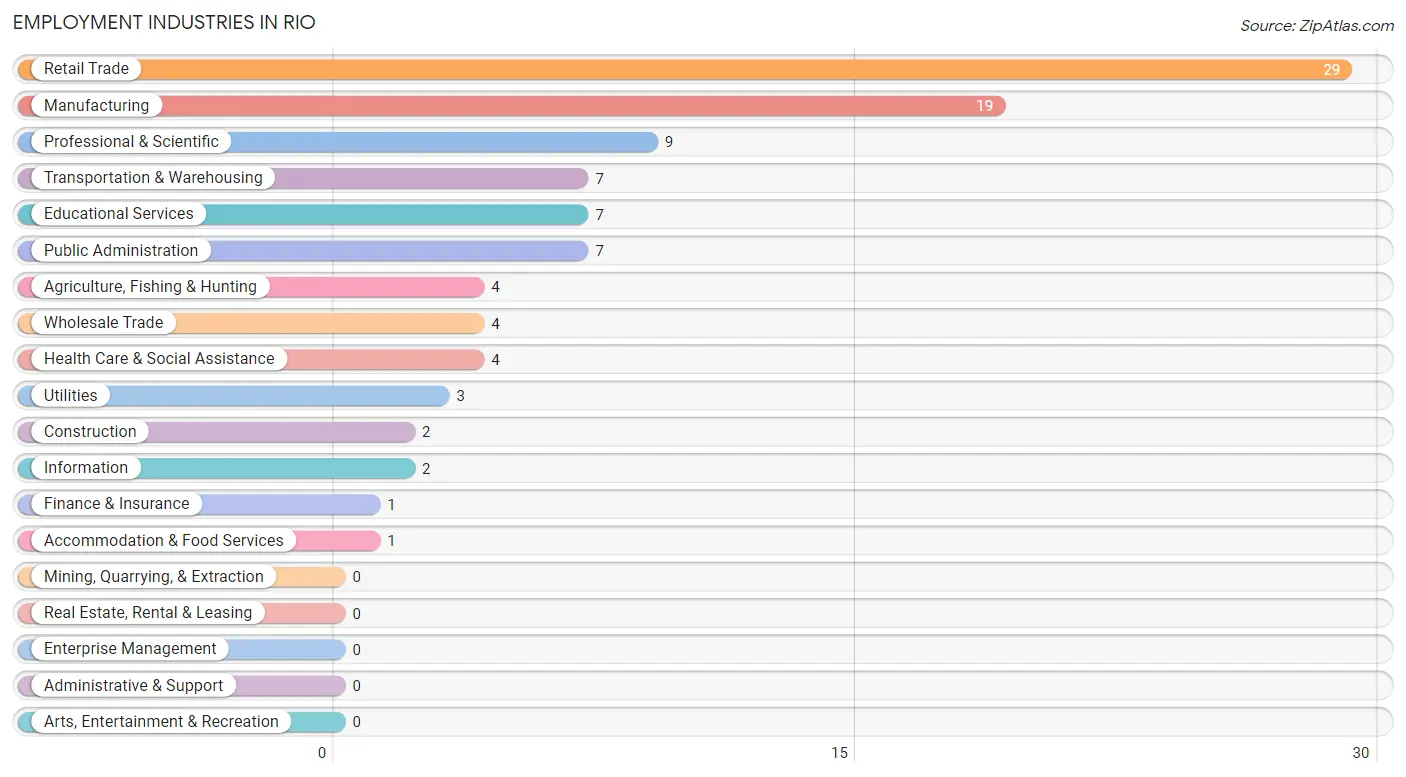
Employment Industries by Sex in Rio
The Rio industries that see more men than women are Agriculture, Fishing & Hunting (100.0%), Wholesale Trade (100.0%), and Transportation & Warehousing (100.0%), whereas the industries that tend to have a higher number of women are Construction (100.0%), Finance & Insurance (100.0%), and Health Care & Social Assistance (100.0%).
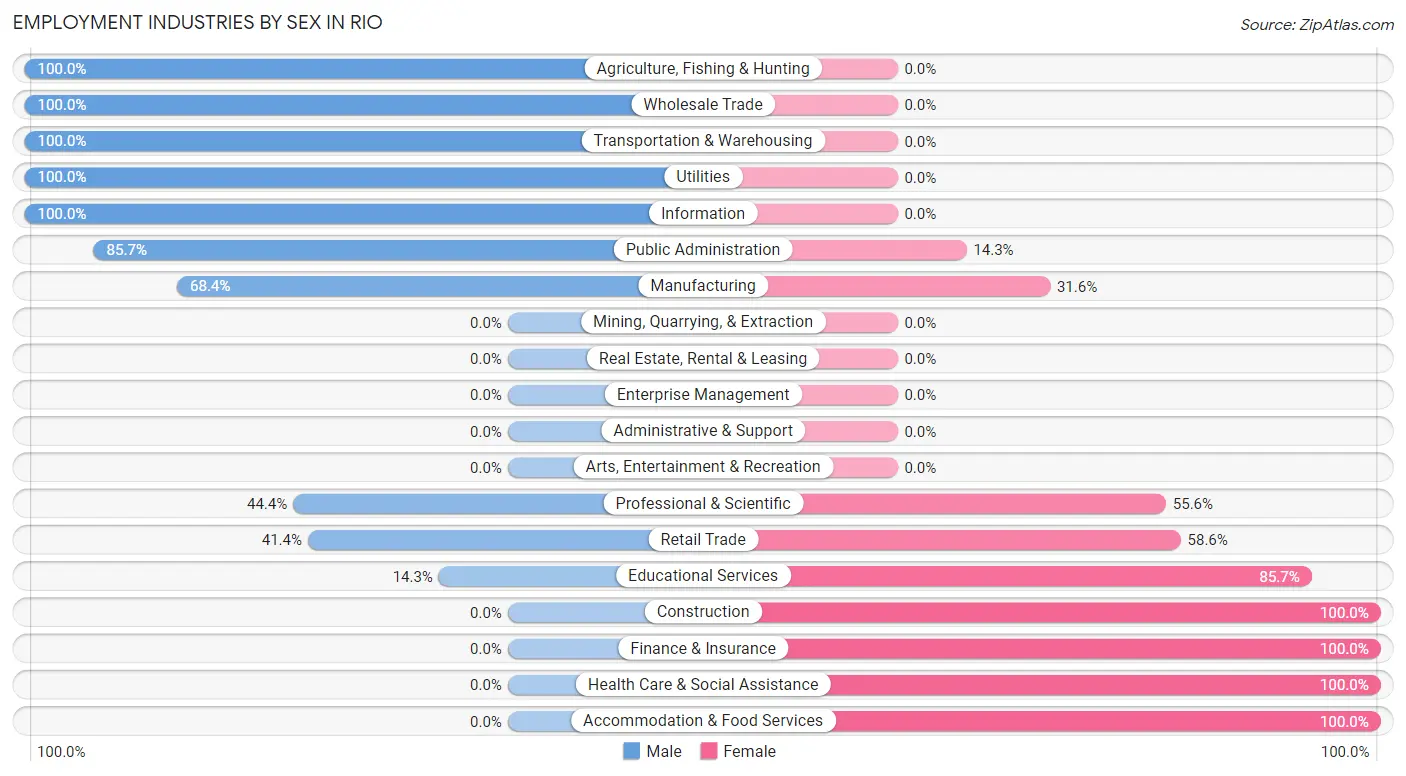
| Industry | Male | Female |
| Agriculture, Fishing & Hunting | 4 (100.0%) | 0 (0.0%) |
| Mining, Quarrying, & Extraction | 0 (0.0%) | 0 (0.0%) |
| Construction | 0 (0.0%) | 2 (100.0%) |
| Manufacturing | 13 (68.4%) | 6 (31.6%) |
| Wholesale Trade | 4 (100.0%) | 0 (0.0%) |
| Retail Trade | 12 (41.4%) | 17 (58.6%) |
| Transportation & Warehousing | 7 (100.0%) | 0 (0.0%) |
| Utilities | 3 (100.0%) | 0 (0.0%) |
| Information | 2 (100.0%) | 0 (0.0%) |
| Finance & Insurance | 0 (0.0%) | 1 (100.0%) |
| Real Estate, Rental & Leasing | 0 (0.0%) | 0 (0.0%) |
| Professional & Scientific | 4 (44.4%) | 5 (55.6%) |
| Enterprise Management | 0 (0.0%) | 0 (0.0%) |
| Administrative & Support | 0 (0.0%) | 0 (0.0%) |
| Educational Services | 1 (14.3%) | 6 (85.7%) |
| Health Care & Social Assistance | 0 (0.0%) | 4 (100.0%) |
| Arts, Entertainment & Recreation | 0 (0.0%) | 0 (0.0%) |
| Accommodation & Food Services | 0 (0.0%) | 1 (100.0%) |
| Public Administration | 6 (85.7%) | 1 (14.3%) |
| Total | 58 (57.4%) | 43 (42.6%) |
Education in Rio
School Enrollment in Rio
The most common levels of schooling among the 26 students in Rio are college / undergraduate (10 | 38.5%), elementary school (8 | 30.8%), and high school (3 | 11.5%).

| School Level | # Students | % Students |
| Nursery / Preschool | 0 | 0.0% |
| Kindergarten | 0 | 0.0% |
| Elementary School | 8 | 30.8% |
| Middle School | 2 | 7.7% |
| High School | 3 | 11.5% |
| College / Undergraduate | 10 | 38.5% |
| Graduate / Professional | 3 | 11.5% |
| Total | 26 | 100.0% |
School Enrollment by Age by Funding Source in Rio
Out of a total of 26 students who are enrolled in schools in Rio, 3 (11.5%) attend a private institution, while the remaining 23 (88.5%) are enrolled in public schools. The age group of 35 years and over has the highest likelihood of being enrolled in private schools, with 3 (100.0% in the age bracket) enrolled. Conversely, the age group of 5 to 9 year old has the lowest likelihood of being enrolled in a private school, with 8 (100.0% in the age bracket) attending a public institution.

| Age Bracket | Public School | Private School |
| 3 to 4 Year Olds | 0 (0.0%) | 0 (0.0%) |
| 5 to 9 Year Old | 8 (100.0%) | 0 (0.0%) |
| 10 to 14 Year Olds | 2 (100.0%) | 0 (0.0%) |
| 15 to 17 Year Olds | 3 (100.0%) | 0 (0.0%) |
| 18 to 19 Year Olds | 4 (100.0%) | 0 (0.0%) |
| 20 to 24 Year Olds | 4 (100.0%) | 0 (0.0%) |
| 25 to 34 Year Olds | 2 (100.0%) | 0 (0.0%) |
| 35 Years and over | 0 (0.0%) | 3 (100.0%) |
| Total | 23 (88.5%) | 3 (11.5%) |
Educational Attainment by Field of Study in Rio
Education (5 | 22.7%), engineering (4 | 18.2%), science & technology (4 | 18.2%), arts & humanities (3 | 13.6%), and bio, nature & agricultural (2 | 9.1%) are the most common fields of study among 22 individuals in Rio who have obtained a bachelor's degree or higher.
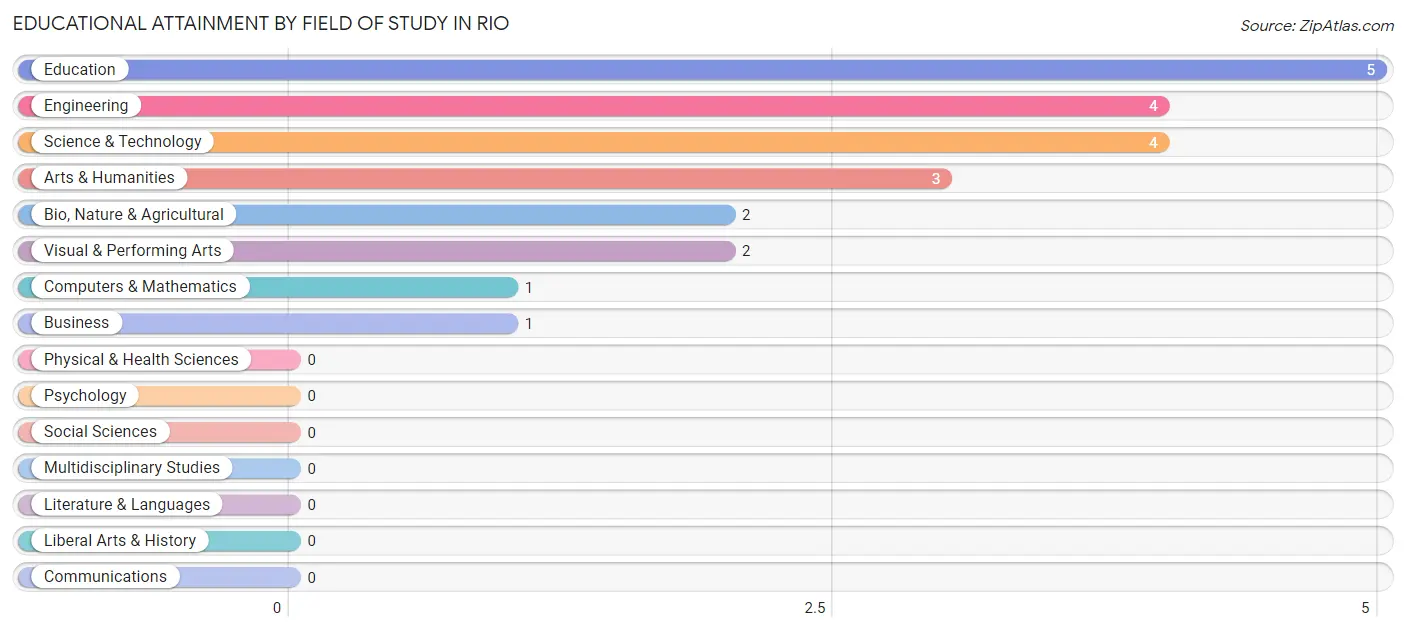
| Field of Study | # Graduates | % Graduates |
| Computers & Mathematics | 1 | 4.5% |
| Bio, Nature & Agricultural | 2 | 9.1% |
| Physical & Health Sciences | 0 | 0.0% |
| Psychology | 0 | 0.0% |
| Social Sciences | 0 | 0.0% |
| Engineering | 4 | 18.2% |
| Multidisciplinary Studies | 0 | 0.0% |
| Science & Technology | 4 | 18.2% |
| Business | 1 | 4.5% |
| Education | 5 | 22.7% |
| Literature & Languages | 0 | 0.0% |
| Liberal Arts & History | 0 | 0.0% |
| Visual & Performing Arts | 2 | 9.1% |
| Communications | 0 | 0.0% |
| Arts & Humanities | 3 | 13.6% |
| Total | 22 | 100.0% |
Transportation & Commute in Rio
Vehicle Availability by Sex in Rio
The most prevalent vehicle ownership categories in Rio are males with 2 vehicles (17, accounting for 29.3%) and females with 2 vehicles (19, making up 39.5%).

| Vehicles Available | Male | Female |
| No Vehicle | 0 (0.0%) | 0 (0.0%) |
| 1 Vehicle | 16 (27.6%) | 7 (16.3%) |
| 2 Vehicles | 17 (29.3%) | 19 (44.2%) |
| 3 Vehicles | 7 (12.1%) | 12 (27.9%) |
| 4 Vehicles | 11 (19.0%) | 5 (11.6%) |
| 5 or more Vehicles | 7 (12.1%) | 0 (0.0%) |
| Total | 58 (100.0%) | 43 (100.0%) |
Commute Time in Rio
The most frequently occuring commute durations in Rio are 15 to 19 minutes (25 commuters, 28.4%), 10 to 14 minutes (15 commuters, 17.1%), and 40 to 44 minutes (11 commuters, 12.5%).
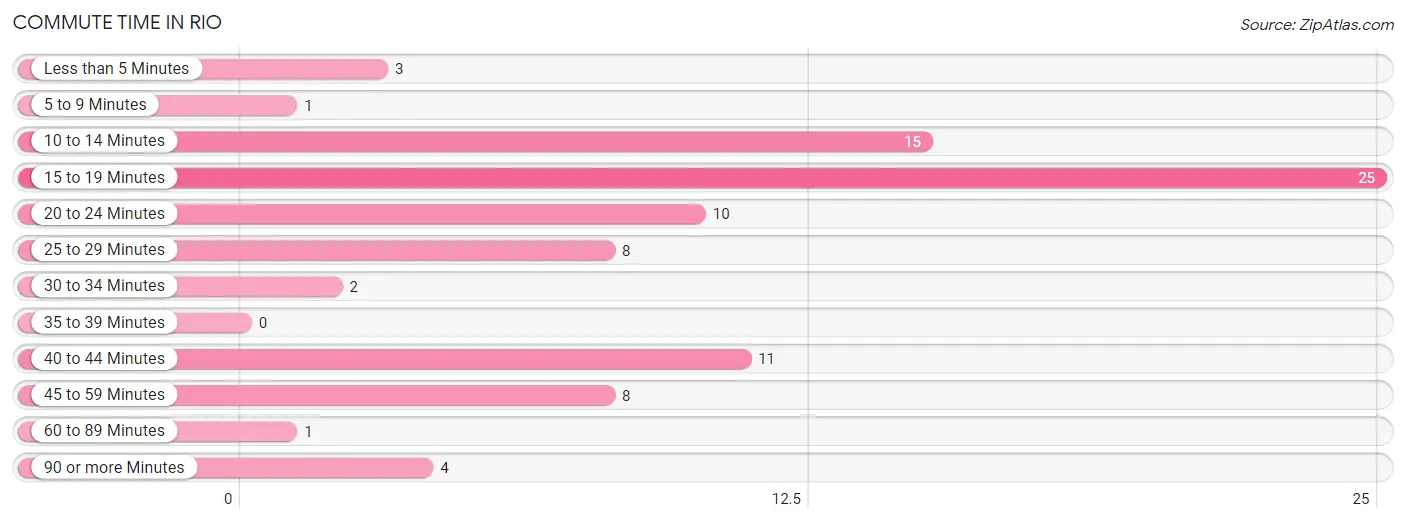
| Commute Time | # Commuters | % Commuters |
| Less than 5 Minutes | 3 | 3.4% |
| 5 to 9 Minutes | 1 | 1.1% |
| 10 to 14 Minutes | 15 | 17.1% |
| 15 to 19 Minutes | 25 | 28.4% |
| 20 to 24 Minutes | 10 | 11.4% |
| 25 to 29 Minutes | 8 | 9.1% |
| 30 to 34 Minutes | 2 | 2.3% |
| 35 to 39 Minutes | 0 | 0.0% |
| 40 to 44 Minutes | 11 | 12.5% |
| 45 to 59 Minutes | 8 | 9.1% |
| 60 to 89 Minutes | 1 | 1.1% |
| 90 or more Minutes | 4 | 4.5% |
Commute Time by Sex in Rio
The most common commute times in Rio are 15 to 19 minutes (17 commuters, 29.3%) for males and 15 to 19 minutes (8 commuters, 26.7%) for females.
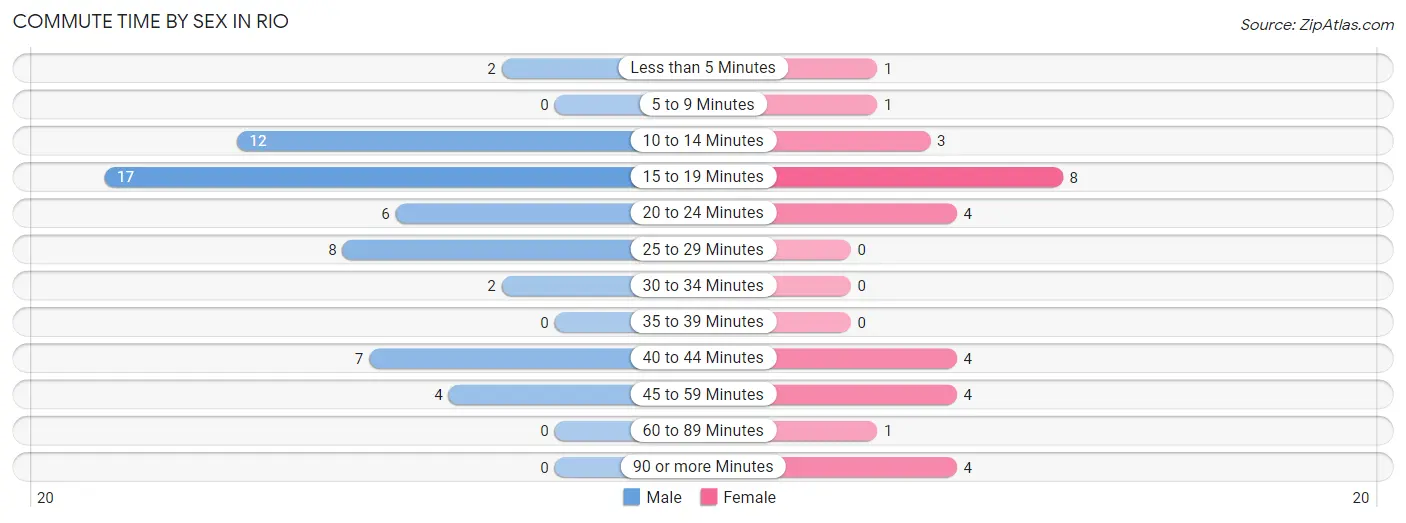
| Commute Time | Male | Female |
| Less than 5 Minutes | 2 (3.5%) | 1 (3.3%) |
| 5 to 9 Minutes | 0 (0.0%) | 1 (3.3%) |
| 10 to 14 Minutes | 12 (20.7%) | 3 (10.0%) |
| 15 to 19 Minutes | 17 (29.3%) | 8 (26.7%) |
| 20 to 24 Minutes | 6 (10.3%) | 4 (13.3%) |
| 25 to 29 Minutes | 8 (13.8%) | 0 (0.0%) |
| 30 to 34 Minutes | 2 (3.5%) | 0 (0.0%) |
| 35 to 39 Minutes | 0 (0.0%) | 0 (0.0%) |
| 40 to 44 Minutes | 7 (12.1%) | 4 (13.3%) |
| 45 to 59 Minutes | 4 (6.9%) | 4 (13.3%) |
| 60 to 89 Minutes | 0 (0.0%) | 1 (3.3%) |
| 90 or more Minutes | 0 (0.0%) | 4 (13.3%) |
Time of Departure to Work by Sex in Rio
The most frequent times of departure to work in Rio are 12:00 AM to 4:59 AM (17, 29.3%) for males and 12:00 AM to 4:59 AM (6, 20.0%) for females.
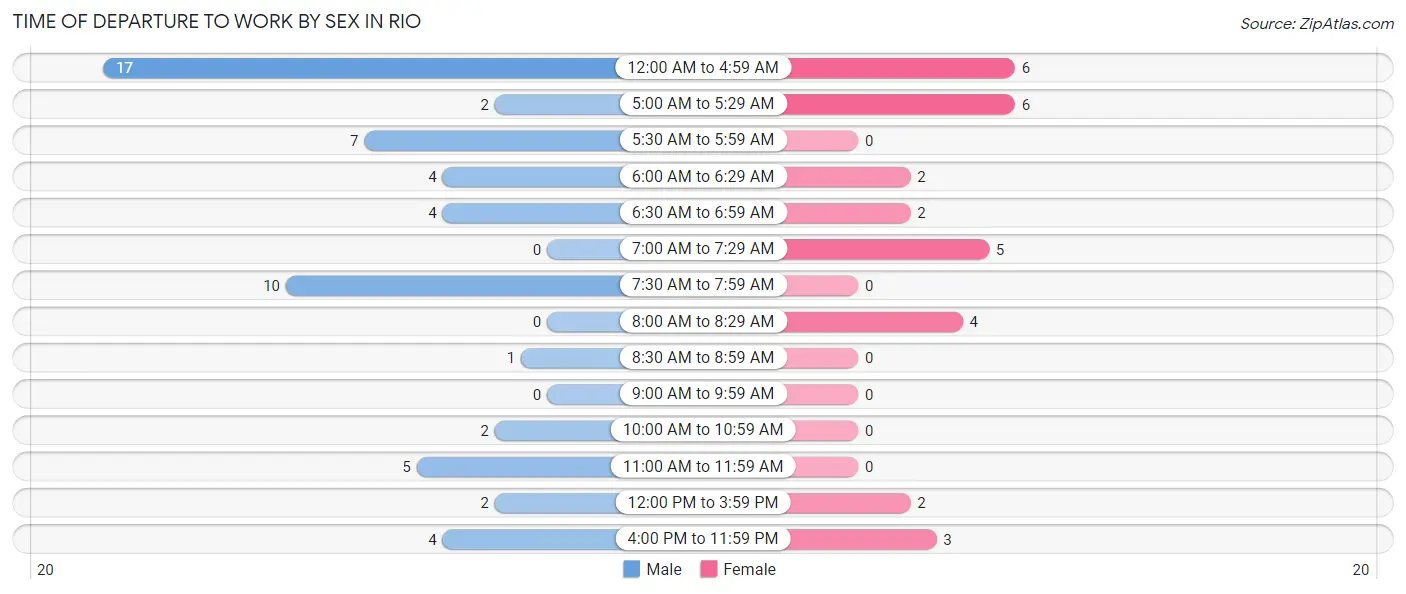
| Time of Departure | Male | Female |
| 12:00 AM to 4:59 AM | 17 (29.3%) | 6 (20.0%) |
| 5:00 AM to 5:29 AM | 2 (3.5%) | 6 (20.0%) |
| 5:30 AM to 5:59 AM | 7 (12.1%) | 0 (0.0%) |
| 6:00 AM to 6:29 AM | 4 (6.9%) | 2 (6.7%) |
| 6:30 AM to 6:59 AM | 4 (6.9%) | 2 (6.7%) |
| 7:00 AM to 7:29 AM | 0 (0.0%) | 5 (16.7%) |
| 7:30 AM to 7:59 AM | 10 (17.2%) | 0 (0.0%) |
| 8:00 AM to 8:29 AM | 0 (0.0%) | 4 (13.3%) |
| 8:30 AM to 8:59 AM | 1 (1.7%) | 0 (0.0%) |
| 9:00 AM to 9:59 AM | 0 (0.0%) | 0 (0.0%) |
| 10:00 AM to 10:59 AM | 2 (3.5%) | 0 (0.0%) |
| 11:00 AM to 11:59 AM | 5 (8.6%) | 0 (0.0%) |
| 12:00 PM to 3:59 PM | 2 (3.5%) | 2 (6.7%) |
| 4:00 PM to 11:59 PM | 4 (6.9%) | 3 (10.0%) |
| Total | 58 (100.0%) | 30 (100.0%) |
Housing Occupancy in Rio
Occupancy by Ownership in Rio
Of the total 79 dwellings in Rio, owner-occupied units account for 62 (78.5%), while renter-occupied units make up 17 (21.5%).

| Occupancy | # Housing Units | % Housing Units |
| Owner Occupied Housing Units | 62 | 78.5% |
| Renter-Occupied Housing Units | 17 | 21.5% |
| Total Occupied Housing Units | 79 | 100.0% |
Occupancy by Household Size in Rio

| Household Size | # Housing Units | % Housing Units |
| 1-Person Household | 19 | 24.0% |
| 2-Person Household | 28 | 35.4% |
| 3-Person Household | 22 | 27.9% |
| 4+ Person Household | 10 | 12.7% |
| Total Housing Units | 79 | 100.0% |
Occupancy by Ownership by Household Size in Rio

| Household Size | Owner-occupied | Renter-occupied |
| 1-Person Household | 14 (73.7%) | 5 (26.3%) |
| 2-Person Household | 24 (85.7%) | 4 (14.3%) |
| 3-Person Household | 17 (77.3%) | 5 (22.7%) |
| 4+ Person Household | 7 (70.0%) | 3 (30.0%) |
| Total Housing Units | 62 (78.5%) | 17 (21.5%) |
Occupancy by Educational Attainment in Rio

| Household Size | Owner-occupied | Renter-occupied |
| Less than High School | 3 (100.0%) | 0 (0.0%) |
| High School Diploma | 20 (80.0%) | 5 (20.0%) |
| College/Associate Degree | 29 (74.4%) | 10 (25.6%) |
| Bachelor's Degree or higher | 10 (83.3%) | 2 (16.7%) |
Occupancy by Age of Householder in Rio

| Age Bracket | # Households | % Households |
| Under 35 Years | 9 | 11.4% |
| 35 to 44 Years | 9 | 11.4% |
| 45 to 54 Years | 22 | 27.9% |
| 55 to 64 Years | 14 | 17.7% |
| 65 to 74 Years | 11 | 13.9% |
| 75 to 84 Years | 7 | 8.9% |
| 85 Years and Over | 7 | 8.9% |
| Total | 79 | 100.0% |
Housing Finances in Rio
Median Income by Occupancy in Rio

| Occupancy Type | # Households | Median Income |
| Owner-Occupied | 62 (78.5%) | $87,083 |
| Renter-Occupied | 17 (21.5%) | $38,125 |
| Average | 79 (100.0%) | $73,750 |
Occupancy by Householder Income Bracket in Rio
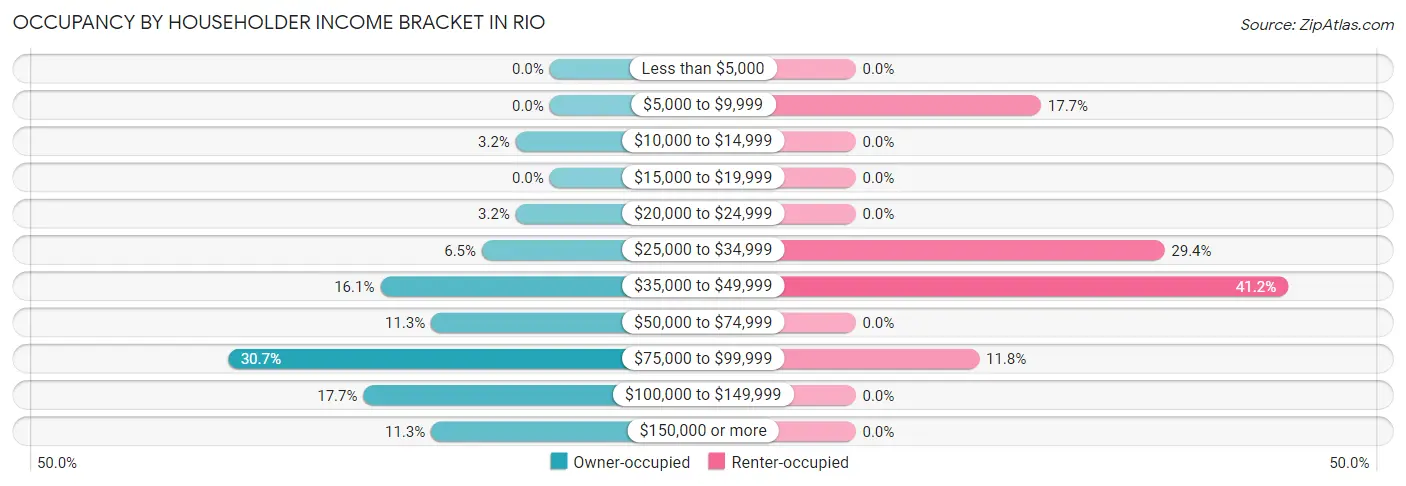
| Income Bracket | Owner-occupied | Renter-occupied |
| Less than $5,000 | 0 (0.0%) | 0 (0.0%) |
| $5,000 to $9,999 | 0 (0.0%) | 3 (17.6%) |
| $10,000 to $14,999 | 2 (3.2%) | 0 (0.0%) |
| $15,000 to $19,999 | 0 (0.0%) | 0 (0.0%) |
| $20,000 to $24,999 | 2 (3.2%) | 0 (0.0%) |
| $25,000 to $34,999 | 4 (6.5%) | 5 (29.4%) |
| $35,000 to $49,999 | 10 (16.1%) | 7 (41.2%) |
| $50,000 to $74,999 | 7 (11.3%) | 0 (0.0%) |
| $75,000 to $99,999 | 19 (30.6%) | 2 (11.8%) |
| $100,000 to $149,999 | 11 (17.7%) | 0 (0.0%) |
| $150,000 or more | 7 (11.3%) | 0 (0.0%) |
| Total | 62 (100.0%) | 17 (100.0%) |
Monthly Housing Cost Tiers in Rio

| Monthly Cost | Owner-occupied | Renter-occupied |
| Less than $300 | 2 (3.2%) | 0 (0.0%) |
| $300 to $499 | 12 (19.4%) | 0 (0.0%) |
| $500 to $799 | 18 (29.0%) | 12 (70.6%) |
| $800 to $999 | 18 (29.0%) | 3 (17.6%) |
| $1,000 to $1,499 | 9 (14.5%) | 2 (11.8%) |
| $1,500 to $1,999 | 3 (4.8%) | 0 (0.0%) |
| $2,000 to $2,499 | 0 (0.0%) | 0 (0.0%) |
| $2,500 to $2,999 | 0 (0.0%) | 0 (0.0%) |
| $3,000 or more | 0 (0.0%) | 0 (0.0%) |
| Total | 62 (100.0%) | 17 (100.0%) |
Physical Housing Characteristics in Rio
Housing Structures in Rio

| Structure Type | # Housing Units | % Housing Units |
| Single Unit, Detached | 72 | 91.1% |
| Single Unit, Attached | 2 | 2.5% |
| 2 Unit Apartments | 0 | 0.0% |
| 3 or 4 Unit Apartments | 5 | 6.3% |
| 5 to 9 Unit Apartments | 0 | 0.0% |
| 10 or more Apartments | 0 | 0.0% |
| Mobile Home / Other | 0 | 0.0% |
| Total | 79 | 100.0% |
Housing Structures by Occupancy in Rio

| Structure Type | Owner-occupied | Renter-occupied |
| Single Unit, Detached | 62 (86.1%) | 10 (13.9%) |
| Single Unit, Attached | 0 (0.0%) | 2 (100.0%) |
| 2 Unit Apartments | 0 (0.0%) | 0 (0.0%) |
| 3 or 4 Unit Apartments | 0 (0.0%) | 5 (100.0%) |
| 5 to 9 Unit Apartments | 0 (0.0%) | 0 (0.0%) |
| 10 or more Apartments | 0 (0.0%) | 0 (0.0%) |
| Mobile Home / Other | 0 (0.0%) | 0 (0.0%) |
| Total | 62 (78.5%) | 17 (21.5%) |
Housing Structures by Number of Rooms in Rio

| Number of Rooms | Owner-occupied | Renter-occupied |
| 1 Room | 0 (0.0%) | 0 (0.0%) |
| 2 or 3 Rooms | 0 (0.0%) | 2 (11.8%) |
| 4 or 5 Rooms | 13 (21.0%) | 0 (0.0%) |
| 6 or 7 Rooms | 30 (48.4%) | 15 (88.2%) |
| 8 or more Rooms | 19 (30.6%) | 0 (0.0%) |
| Total | 62 (100.0%) | 17 (100.0%) |
Housing Structure by Heating Type in Rio

| Heating Type | Owner-occupied | Renter-occupied |
| Utility Gas | 49 (79.0%) | 13 (76.5%) |
| Bottled, Tank, or LP Gas | 0 (0.0%) | 0 (0.0%) |
| Electricity | 12 (19.4%) | 4 (23.5%) |
| Fuel Oil or Kerosene | 0 (0.0%) | 0 (0.0%) |
| Coal or Coke | 0 (0.0%) | 0 (0.0%) |
| All other Fuels | 1 (1.6%) | 0 (0.0%) |
| No Fuel Used | 0 (0.0%) | 0 (0.0%) |
| Total | 62 (100.0%) | 17 (100.0%) |
Household Vehicle Usage in Rio

| Vehicles per Household | Owner-occupied | Renter-occupied |
| No Vehicle | 0 (0.0%) | 0 (0.0%) |
| 1 Vehicle | 25 (40.3%) | 7 (41.2%) |
| 2 Vehicles | 17 (27.4%) | 10 (58.8%) |
| 3 or more Vehicles | 20 (32.3%) | 0 (0.0%) |
| Total | 62 (100.0%) | 17 (100.0%) |
Real Estate & Mortgages in Rio
Real Estate and Mortgage Overview in Rio
| Characteristic | Without Mortgage | With Mortgage |
| Housing Units | 29 | 33 |
| Median Property Value | $108,900 | $92,500 |
| Median Household Income | $64,375 | $4 |
| Monthly Housing Costs | $525 | $0 |
| Real Estate Taxes | $2,300 | $3 |
Property Value by Mortgage Status in Rio

| Property Value | Without Mortgage | With Mortgage |
| Less than $50,000 | 1 (3.5%) | 6 (18.2%) |
| $50,000 to $99,999 | 11 (37.9%) | 12 (36.4%) |
| $100,000 to $299,999 | 17 (58.6%) | 15 (45.5%) |
| $300,000 to $499,999 | 0 (0.0%) | 0 (0.0%) |
| $500,000 to $749,999 | 0 (0.0%) | 0 (0.0%) |
| $750,000 to $999,999 | 0 (0.0%) | 0 (0.0%) |
| $1,000,000 or more | 0 (0.0%) | 0 (0.0%) |
| Total | 29 (100.0%) | 33 (100.0%) |
Household Income by Mortgage Status in Rio

| Household Income | Without Mortgage | With Mortgage |
| Less than $10,000 | 0 (0.0%) | 0 (0.0%) |
| $10,000 to $24,999 | 4 (13.8%) | 0 (0.0%) |
| $25,000 to $34,999 | 1 (3.5%) | 0 (0.0%) |
| $35,000 to $49,999 | 5 (17.2%) | 3 (9.1%) |
| $50,000 to $74,999 | 6 (20.7%) | 5 (15.1%) |
| $75,000 to $99,999 | 6 (20.7%) | 1 (3.0%) |
| $100,000 to $149,999 | 4 (13.8%) | 13 (39.4%) |
| $150,000 or more | 3 (10.3%) | 7 (21.2%) |
| Total | 29 (100.0%) | 33 (100.0%) |
Property Value to Household Income Ratio in Rio

| Value-to-Income Ratio | Without Mortgage | With Mortgage |
| Less than 2.0x | 17 (58.6%) | 89,375 (270,833.3%) |
| 2.0x to 2.9x | 7 (24.1%) | 30 (90.9%) |
| 3.0x to 3.9x | 3 (10.3%) | 1 (3.0%) |
| 4.0x or more | 2 (6.9%) | 2 (6.1%) |
| Total | 29 (100.0%) | 33 (100.0%) |
Real Estate Taxes by Mortgage Status in Rio

| Property Taxes | Without Mortgage | With Mortgage |
| Less than $800 | 3 (10.3%) | 0 (0.0%) |
| $800 to $1,499 | 3 (10.3%) | 6 (18.2%) |
| $800 to $1,499 | 23 (79.3%) | 2 (6.1%) |
| Total | 29 (100.0%) | 33 (100.0%) |
Health & Disability in Rio
Health Insurance Coverage by Age in Rio

| Age Bracket | With Coverage | Without Coverage |
| Under 6 Years | 18 (100.0%) | 0 (0.0%) |
| 6 to 18 Years | 16 (100.0%) | 0 (0.0%) |
| 19 to 25 Years | 20 (100.0%) | 0 (0.0%) |
| 26 to 34 Years | 25 (92.6%) | 2 (7.4%) |
| 35 to 44 Years | 8 (61.5%) | 5 (38.5%) |
| 45 to 54 Years | 37 (100.0%) | 0 (0.0%) |
| 55 to 64 Years | 22 (95.7%) | 1 (4.3%) |
| 65 to 74 Years | 15 (100.0%) | 0 (0.0%) |
| 75 Years and older | 26 (100.0%) | 0 (0.0%) |
| Total | 187 (95.9%) | 8 (4.1%) |
Health Insurance Coverage by Citizenship Status in Rio

| Citizenship Status | With Coverage | Without Coverage |
| Native Born | 18 (100.0%) | 0 (0.0%) |
| Foreign Born, Citizen | 16 (100.0%) | 0 (0.0%) |
| Foreign Born, not a Citizen | 20 (100.0%) | 0 (0.0%) |
Health Insurance Coverage by Household Income in Rio

| Household Income | With Coverage | Without Coverage |
| Under $25,000 | 23 (100.0%) | 0 (0.0%) |
| $25,000 to $49,999 | 47 (88.7%) | 6 (11.3%) |
| $50,000 to $74,999 | 16 (100.0%) | 0 (0.0%) |
| $75,000 to $99,999 | 58 (96.7%) | 2 (3.3%) |
| $100,000 and over | 43 (100.0%) | 0 (0.0%) |
Public vs Private Health Insurance Coverage by Age in Rio

| Age Bracket | Public Insurance | Private Insurance |
| Under 6 | 18 (100.0%) | 0 (0.0%) |
| 6 to 18 Years | 10 (62.5%) | 6 (37.5%) |
| 19 to 25 Years | 4 (20.0%) | 16 (80.0%) |
| 25 to 34 Years | 8 (29.6%) | 19 (70.4%) |
| 35 to 44 Years | 0 (0.0%) | 8 (61.5%) |
| 45 to 54 Years | 6 (16.2%) | 36 (97.3%) |
| 55 to 64 Years | 5 (21.7%) | 18 (78.3%) |
| 65 to 74 Years | 15 (100.0%) | 10 (66.7%) |
| 75 Years and over | 25 (96.2%) | 16 (61.5%) |
| Total | 91 (46.7%) | 129 (66.1%) |
Disability Status by Sex by Age in Rio

| Age Bracket | Male | Female |
| Under 5 Years | 0 (0.0%) | 0 (0.0%) |
| 5 to 17 Years | 0 (0.0%) | 0 (0.0%) |
| 18 to 34 Years | 0 (0.0%) | 0 (0.0%) |
| 35 to 64 Years | 5 (13.9%) | 3 (8.1%) |
| 65 to 74 Years | 1 (20.0%) | 0 (0.0%) |
| 75 Years and over | 8 (53.3%) | 5 (45.5%) |
Disability Class by Sex by Age in Rio
Disability Class: Hearing Difficulty

| Age Bracket | Male | Female |
| Under 5 Years | 0 (0.0%) | 0 (0.0%) |
| 5 to 17 Years | 0 (0.0%) | 0 (0.0%) |
| 18 to 34 Years | 0 (0.0%) | 0 (0.0%) |
| 35 to 64 Years | 0 (0.0%) | 0 (0.0%) |
| 65 to 74 Years | 1 (20.0%) | 0 (0.0%) |
| 75 Years and over | 1 (6.7%) | 1 (9.1%) |
Disability Class: Vision Difficulty

| Age Bracket | Male | Female |
| Under 5 Years | 0 (0.0%) | 0 (0.0%) |
| 5 to 17 Years | 0 (0.0%) | 0 (0.0%) |
| 18 to 34 Years | 0 (0.0%) | 0 (0.0%) |
| 35 to 64 Years | 2 (5.6%) | 0 (0.0%) |
| 65 to 74 Years | 0 (0.0%) | 0 (0.0%) |
| 75 Years and over | 0 (0.0%) | 2 (18.2%) |
Disability Class: Cognitive Difficulty

| Age Bracket | Male | Female |
| 5 to 17 Years | 0 (0.0%) | 0 (0.0%) |
| 18 to 34 Years | 0 (0.0%) | 0 (0.0%) |
| 35 to 64 Years | 3 (8.3%) | 0 (0.0%) |
| 65 to 74 Years | 0 (0.0%) | 0 (0.0%) |
| 75 Years and over | 3 (20.0%) | 4 (36.4%) |
Disability Class: Ambulatory Difficulty

| Age Bracket | Male | Female |
| 5 to 17 Years | 0 (0.0%) | 0 (0.0%) |
| 18 to 34 Years | 0 (0.0%) | 0 (0.0%) |
| 35 to 64 Years | 1 (2.8%) | 3 (8.1%) |
| 65 to 74 Years | 0 (0.0%) | 0 (0.0%) |
| 75 Years and over | 4 (26.7%) | 4 (36.4%) |
Disability Class: Self-Care Difficulty

| Age Bracket | Male | Female |
| 5 to 17 Years | 0 (0.0%) | 0 (0.0%) |
| 18 to 34 Years | 0 (0.0%) | 0 (0.0%) |
| 35 to 64 Years | 1 (2.8%) | 3 (8.1%) |
| 65 to 74 Years | 0 (0.0%) | 0 (0.0%) |
| 75 Years and over | 1 (6.7%) | 2 (18.2%) |
Technology Access in Rio
Computing Device Access in Rio

| Device Type | # Households | % Households |
| Desktop or Laptop | 57 | 72.2% |
| Smartphone | 67 | 84.8% |
| Tablet | 42 | 53.2% |
| No Computing Device | 8 | 10.1% |
| Total | 79 | 100.0% |
Internet Access in Rio

| Internet Type | # Households | % Households |
| Dial-Up Internet | 2 | 2.5% |
| Broadband Home | 57 | 72.2% |
| Cellular Data Only | 11 | 13.9% |
| Satellite Internet | 5 | 6.3% |
| No Internet | 9 | 11.4% |
| Total | 79 | 100.0% |
Rio Summary
Rio, Illinois is a small village located in the northern part of the state, in Ogle County. It is situated on the banks of the Rock River, and is part of the Rockford Metropolitan Statistical Area. The village has a population of just over 1,000 people, and is known for its rural charm and small-town atmosphere.
Geography
Rio is located in the northern part of Ogle County, in the Rockford Metropolitan Statistical Area. It is situated on the banks of the Rock River, and is bordered by the towns of Leaf River to the north, Byron to the east, and Oregon to the south. The village is located approximately 80 miles northwest of Chicago, and is accessible via Interstate 39 and U.S. Route 20.
The village is situated on a flat plain, with an elevation of 745 feet above sea level. The climate is humid continental, with hot summers and cold winters. The average annual temperature is around 50 degrees Fahrenheit, and the average annual precipitation is around 36 inches.
Economy
Rio’s economy is largely based on agriculture and manufacturing. The village is home to several small businesses, including a grocery store, a hardware store, and a few restaurants. The village also has a few small industrial parks, which are home to a variety of light manufacturing businesses.
The village is also home to a number of farms, which produce a variety of crops, including corn, soybeans, and wheat. The village is also home to a number of wineries, which produce a variety of wines.
Demographics
As of the 2010 census, the population of Rio was 1,037. The racial makeup of the village was 97.2% White, 0.7% African American, 0.3% Native American, 0.2% Asian, 0.1% Pacific Islander, 0.4% from other races, and 1.1% from two or more races. Hispanic or Latino of any race were 1.7% of the population.
The median income for a household in the village was $45,000, and the median income for a family was $50,000. The per capita income for the village was $20,000. About 8.3% of families and 10.2% of the population were below the poverty line, including 14.3% of those under age 18 and 6.3% of those age 65 or over.
History
Rio was first settled in 1835 by a group of settlers from New York. The village was originally known as “Rio Station”, and was named after the nearby Rock River. The village was incorporated in 1867, and the name was changed to “Rio”.
The village grew slowly over the years, and by the early 1900s, it had become a popular tourist destination. The village was home to a number of resorts, and was known for its fishing and hunting opportunities.
In the 1950s, the village began to decline, as many of the resorts closed and the population began to decline. The village has since seen a resurgence, and is now home to a number of small businesses and a growing population.
Common Questions
What is Per Capita Income in Rio?
Per Capita income in Rio is $33,891.
What is the Median Family Income in Rio?
Median Family Income in Rio is $86,875.
What is the Median Household income in Rio?
Median Household Income in Rio is $73,750.
What is Income or Wage Gap in Rio?
Income or Wage Gap in Rio is 46.9%.
Women in Rio earn 53.1 cents for every dollar earned by a man.
What is Inequality or Gini Index in Rio?
Inequality or Gini Index in Rio is 0.37.
What is the Total Population of Rio?
Total Population of Rio is 195.
What is the Total Male Population of Rio?
Total Male Population of Rio is 86.
What is the Total Female Population of Rio?
Total Female Population of Rio is 109.
What is the Ratio of Males per 100 Females in Rio?
There are 78.90 Males per 100 Females in Rio.
What is the Ratio of Females per 100 Males in Rio?
There are 126.74 Females per 100 Males in Rio.
What is the Median Population Age in Rio?
Median Population Age in Rio is 46.1 Years.
What is the Average Family Size in Rio
Average Family Size in Rio is 2.8 People.
What is the Average Household Size in Rio
Average Household Size in Rio is 2.5 People.
How Large is the Labor Force in Rio?
There are 106 People in the Labor Forcein in Rio.
What is the Percentage of People in the Labor Force in Rio?
63.9% of People are in the Labor Force in Rio.
What is the Unemployment Rate in Rio?
Unemployment Rate in Rio is 4.7%.